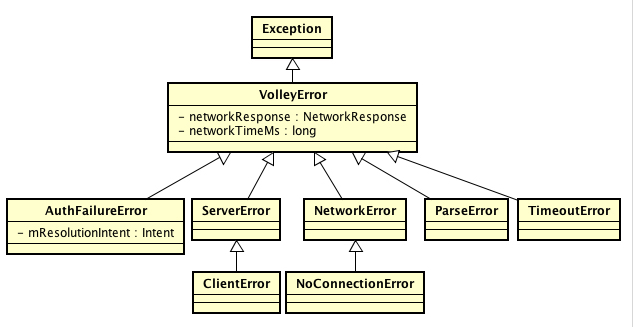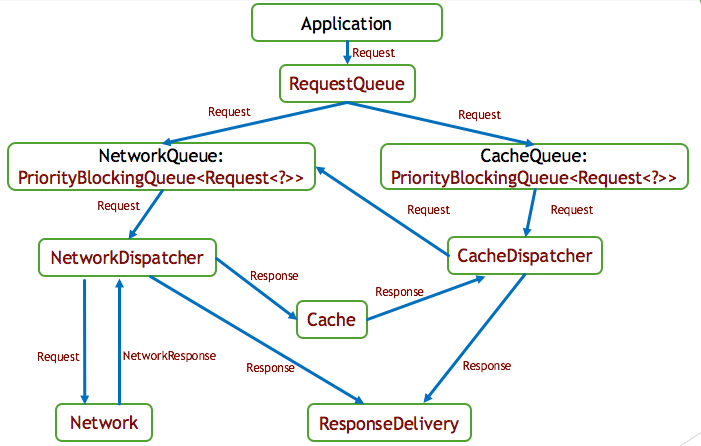Volley设计与实现分析
2016-05-30 23:57
316 查看
Volley设计与实现分析
我们平时在开发Android应用的时候,不可避免地经常要通过网络来进行数据的收发,而多数情况下都是会用HTTP协议来做这些事情。Android系统主要提供了HttpURLConnection和Apache HttpClient这两种方式来帮我们进行HTTP通信。对于这两种方式,Google官方的一份文档 Android’s HTTP Clients 有做一个对比说明。是说,Apache HttpClient提供的API非常多,实现稳定,bug也比较少,正因如此,为了保持API兼容性而非常难以做优化。HttpURLConnection的API比较少,故而比较容易做优化。但在Android 2.3之前,HttpURLConnection的实现又有一些比较严重的问题。Google官方建议在2.2及之前的Android上,用Apache HttpClient来执行HTTP请求,在2.3及之后的Android上,则用HttpURLConnection接口。另外,HttpURLConnection和HttpClient的用法还是有些复杂的,提供的功能也比较基础,如果不进行适当封装的话,很容易写出大量重复代码。于是乎,一些Android网络通信框架也就应运而生,比如说AsyncHttpClient等,它把HTTP所有的通信细节全部封装在内部,同时提供更为强大的API,我们只需简单调用几行代码就可以完成通信操作。
Volley是Google提供的一个HTTP网络库,其功能大体是提供对通信细节的封装,以方便网络操作的调用,volley在内部实现中,会根据运行的android的版本,来决定是使用HttpURLConnection和Apache HttpClient接口;提供缓存机制,以加速网络访问;提供HTTP请求异步执行的能力。这里我们就来看一下Volley的设计和实现。
Volley的获取
我们先来了解一些怎么下载到volley的代码。我们可以通过如下的命令,下载的volley的代码:git clone https://android.googlesource.com/platform/frameworks/volley
下载了volley之后,将代码导入到Android Studio中,根据volley工程的配置对于工具版本的要求,下载必要的工具,比如Android SDK platform,SDK Build tools,Gradle插件,或者根据本地工具链的版本,适当修改volley工程的设置,随后就可以对volley进行编译,产生aar包了。
Volley的使用
这里我们通过一个简单的例子来看一下volley的使用。比如,我们利用淘宝的接口抓取某一个IP地址的相关信息:public class MainActivity extends AppCompatActivity {
private static final String TAG = "myapplication";
private TextView mWeatherDataText;
@Override
protected void onCreate(Bundle savedInstanceState) {
super.onCreate(savedInstanceState);
setContentView(R.layout.activity_main);
mWeatherDataText = (TextView)findViewById(R.id.weather_data);
getIpData();
}
private void getIpData() {
String RegionServiceUrl = "http://ip.taobao.com/service/getIpInfo.php?ip=112.65.189.212";
RequestQueue requestQueue = Volley.newRequestQueue(this);
StringRequest request = new StringRequest(RegionServiceUrl, new Response.Listener<String>() {
@Override
public void onResponse(String response) {
Log.i(TAG, "response = " + response);
mWeatherDataText.setText(response);
}
}, new Response.ErrorListener() {
@Override
public void onErrorResponse(VolleyError error) {
Log.i(TAG, "error = " + error.getMessage());
mWeatherDataText.setText(error.getMessage());
}
});
requestQueue.add(request);
}
}主要关注getIpData(),实际是在这个方法中利用volley,执行了网络请求。可以看到,使用volley执行网络请求,大概分为如下的几个步骤:
通过Volley类获取一个RequestQueue对象。
创建Listener来处理网络操作的返回值。Response.Listener和Response.ErrorListener分别用于处理正常的和异常的返回值。
传入Url,HTTP Method,Listener等参数创建Request。
将前面创建的Request添加到RequestQueue。
通过volley执行基本的网络请求就是这么简单。要执行更复杂的网络请求的话,可以自行探索。
Volley项目的结构
这里我们以2016.5.27 clone下来的代码为基础进行volley整个设计与实现的分析。我们先来看一下Volley的代码结构:com/android/volley/AuthFailureError.java com/android/volley/Cache.java com/android/volley/CacheDispatcher.java com/android/volley/ClientError.java com/android/volley/DefaultRetryPolicy.java com/android/volley/ExecutorDelivery.java com/android/volley/Network.java com/android/volley/NetworkDispatcher.java com/android/volley/NetworkError.java com/android/volley/NetworkResponse.java com/android/volley/NoConnectionError.java com/android/volley/ParseError.java com/android/volley/Request.java com/android/volley/RequestQueue.java com/android/volley/Response.java com/android/volley/ResponseDelivery.java com/android/volley/RetryPolicy.java com/android/volley/ServerError.java com/android/volley/TimeoutError.java com/android/volley/VolleyError.java com/android/volley/VolleyLog.java com/android/volley/toolbox/AndroidAuthenticator.java com/android/volley/toolbox/Authenticator.java com/android/volley/toolbox/BasicNetwork.java com/android/volley/toolbox/ByteArrayPool.java com/android/volley/toolbox/ClearCacheRequest.java com/android/volley/toolbox/DiskBasedCache.java com/android/volley/toolbox/HttpClientStack.java com/android/volley/toolbox/HttpHeaderParser.java com/android/volley/toolbox/HttpStack.java com/android/volley/toolbox/HurlStack.java com/android/volley/toolbox/ImageLoader.java com/android/volley/toolbox/ImageRequest.java com/android/volley/toolbox/JsonArrayRequest.java com/android/volley/toolbox/JsonObjectRequest.java com/android/volley/toolbox/JsonRequest.java com/android/volley/toolbox/NetworkImageView.java com/android/volley/toolbox/NoCache.java com/android/volley/toolbox/PoolingByteArrayOutputStream.java com/android/volley/toolbox/RequestFuture.java com/android/volley/toolbox/StringRequest.java com/android/volley/toolbox/Volley.java
可以看到volley的所有代码都在两个package中,一个是com.android.volley,另一个是com.android.volley.toolbox,前者可以认为是定义了volley的框架架构及接口,而后者则是相关接口的实现,提供实际的诸如HTTP网络访问、缓存等功能。
Volley设计
这里先分析com.android.volley包,来看一下volley整体的框架架构。com.android.volley包中,类名以Error结尾的所有类都是Exception,用来指示某种异常。所有这些类的层次结构如下图:
对于这些Exception类,没有需要过多说明的地方。接下来,我们从网络请求的执行及执行结果的发布的角度来看一下com.android.volley包中各个类之间的关系,如下图:

如我们在上面 Volley的使用 一节中看到的,应用程序在创建了Request之后,会将这个Request丢给RequestQueue,RequestQueue负责这个Request的处理及结果的Post。
RequestQueue在拿到Request之后,会根据这个Request是否应该缓存而将这个Request丢进NetworkQueue或CacheQueue,若Request应该缓存它会被放进CacheQueue中,若不需要则会被直接放进NetworkQueue中。NetworkQueue和CacheQueue都是类型为PriorityBlockingQueue<Request<?>>的容器。
NetworkDispatcher和CacheDispatcher都是Thread。NetworkDispatcher主要的职责是通过Network执行HTTP请求并抛出执行结果。NetworkDispatcher线程在被启动之后,会不断地从NetworkQueue中取出Request来执行,执行之后得到NetworkReponse,NetworkReponse会得到解析并被重新构造为Response,构造后的Response会被丢给ResponseDelivery,并由后者发布给volley的调用者,同时在Request应该被缓存时,获得的Response数据还会被放进Cache中。在Volley中,会创建NetworkDispatcher线程的线程池,其中包含固定的4个线程。
CacheDispatcher的主要职责则是访问缓存,找到之前缓存的下载的数据,并通过ResponseDelivery发布给volley的调用者,在没找到时,则将Request丢进NetworkQueue中,以便于从网络中获取。在Volley中,只有一个CacheDispatcher线程。
Cache主要定义了缓存接口。RetryPolicy定义了缓存策略的接口,每个Request都会有自己的RetryPolicy,用于帮助Network确定重试的策略。ResponseDelivery定义了Request的发布者的行为,ExecutorDelivery是ResponseDelivery的一个实现,它主要是将结果post到一个Executor中。
Volley的实现
接下来通过代码来看一下Volley的实现。RequestQueue对象的创建
在Volley中,主要通过Volley类的newRequest来创建RequestQueue对象。Volley类就像胶水一样,把Network的实现BasicNetwork/HurlStack/HttpClientStack和Cache的实现DiskBasedCache粘到一起,创建出可用的RequestQueue。其代码如下:public class Volley {
/** Default on-disk cache directory. */
private static final String DEFAULT_CACHE_DIR = "volley";
/**
* Creates a default instance of the worker pool and calls {@link RequestQueue#start()} on it.
*
* @param context A {@link Context} to use for creating the cache dir.
* @param stack An {@link HttpStack} to use for the network, or null for default.
* @return A started {@link RequestQueue} instance.
*/
public static RequestQueue newRequestQueue(Context context, HttpStack stack) {
File cacheDir = new File(context.getCacheDir(), DEFAULT_CACHE_DIR);
String userAgent = "volley/0";
try {
String packageName = context.getPackageName();
PackageInfo info = context.getPackageManager().getPackageInfo(packageName, 0);
userAgent = packageName + "/" + info.versionCode;
} catch (NameNotFoundException e) {
}
if (stack == null) {
if (Build.VERSION.SDK_INT >= 9) {
stack = new HurlStack();
} else {
// Prior to Gingerbread, HttpUrlConnection was unreliable.
// See: http://android-developers.blogspot.com/2011/09/androids-http-clients.html stack = new HttpClientStack(AndroidHttpClient.newInstance(userAgent));
}
}
Network network = new BasicNetwork(stack);
RequestQueue queue = new RequestQueue(new DiskBasedCache(cacheDir), network);
queue.start();
return queue;
}
/**
* Creates a default instance of the worker pool and calls {@link RequestQueue#start()} on it.
*
* @param context A {@link Context} to use for creating the cache dir.
* @return A started {@link RequestQueue} instance.
*/
public static RequestQueue newRequestQueue(Context context) {
return newRequestQueue(context, null);
}
}不带HttpStack参数的newRequestQueue()方法就是我们前面用到的那个,它会直接传入null HttpStack调用带HttpStack参数的newRequestQueue()方法。带参数的newRequestQueue()方法的实现,感觉改为下面这样似乎更加清晰一点:
public static RequestQueue newRequestQueue(Context context, HttpStack stack) {
if (stack == null) {
if (Build.VERSION.SDK_INT >= 9) {
stack = new HurlStack();
} else {
String userAgent = "volley/0";
try {
String packageName = context.getPackageName();
PackageInfo info = context.getPackageManager().getPackageInfo(packageName, 0);
userAgent = packageName + "/" + info.versionCode;
} catch (NameNotFoundException e) {
}
// Prior to Gingerbread, HttpUrlConnection was unreliable.
// See: http://android-developers.blogspot.com/2011/09/androids-http-clients.html stack = new HttpClientStack(AndroidHttpClient.newInstance(userAgent));
}
}
Network network = new BasicNetwork(stack);
File cacheDir = new File(context.getCacheDir(), DEFAULT_CACHE_DIR);
RequestQueue queue = new RequestQueue(new DiskBasedCache(cacheDir), network);
queue.start();
return queue;
}以上面的这段代码为基础,来分析newRequestQueue()方法做的事情。可以看到它主要做了如下这样几件事情:
在HttpStack参数为空时,创建HttpStack。HttpStack的职责主要是直接的执行网络请求,并返回HttpResponse。BasicNetwork通过HttpStack执行网络请求,对返回的HttpResponse做一些处理,然后构造NetworkResponse返回给调用者。这里会根据系统当前的版本,来选择是使用HttpClient接口还是HttpURLConnection接口,也就是使用HttpClientStack还是HurlStack,这两个class都是实现了HttpStack接口。这里可以来看一下HttpStack接口的定义:
public interface HttpStack {
/**
* Performs an HTTP request with the given parameters.
*
* A GET request is sent if request.getPostBody() == null. A POST request is sent otherwise,
* and the Content-Type header is set to request.getPostBodyContentType().
*
* @param request the request to perform
* @param additionalHeaders additional headers to be sent together with
* {@link Request#getHeaders()}
* @return the HTTP response
*/
public HttpResponse performRequest(Request<?> request, Map<String, String> additionalHeaders)
throws IOException, AuthFailureError;
}HurlStack的对象创建过程:
/**
* An interface for transforming URLs before use.
*/
public interface UrlRewriter {
/**
* Returns a URL to use instead of the provided one, or null to indicate
* this URL should not be used at all.
*/
public String rewriteUrl(String originalUrl);
}
private final UrlRewriter mUrlRewriter;
private final SSLSocketFactory mSslSocketFactory;
public HurlStack() {
this(null);
}
/**
* @param urlRewriter Rewriter to use for request URLs
*/
public HurlStack(UrlRewriter urlRewriter) {
this(urlRewriter, null);
}
/**
* @param urlRewriter Rewriter to use for request URLs
* @param sslSocketFactory SSL factory to use for HTTPS connections
*/
public HurlStack(UrlRewriter urlRewriter, SSLSocketFactory sslSocketFactory) {
mUrlRewriter = urlRewriter;
mSslSocketFactory = sslSocketFactory;
}然后是HttpClientStack对象的创建过程:
protected final HttpClient mClient;
private final static String HEADER_CONTENT_TYPE = "Content-Type";
public HttpClientStack(HttpClient client) {
mClient = client;
}利用HttpStack创建BasicNetwork对象,其过程为:
protected final HttpStack mHttpStack;
protected final ByteArrayPool mPool;
/**
* @param httpStack HTTP stack to be used
*/
public BasicNetwork(HttpStack httpStack) {
// If a pool isn't passed in, then build a small default pool that will give us a lot of
// benefit and not use too much memory.
this(httpStack, new ByteArrayPool(DEFAULT_POOL_SIZE));
}
/**
* @param httpStack HTTP stack to be used
* @param pool a buffer pool that improves GC performance in copy operations
*/
public BasicNetwork(HttpStack httpStack, ByteArrayPool pool) {
mHttpStack = httpStack;
mPool = pool;
}创建DiskBasedCache对象。
/** Default maximum disk usage in bytes. */
private static final int DEFAULT_DISK_USAGE_BYTES = 5 * 1024 * 1024;
/** High water mark percentage for the cache */
private static final float HYSTERESIS_FACTOR = 0.9f;
/** Magic number for current version of cache file format. */
private static final int CACHE_MAGIC = 0x20150306;
/**
* Constructs an instance of the DiskBasedCache at the specified directory.
* @param rootDirectory The root directory of the cache.
* @param maxCacheSizeInBytes The maximum size of the cache in bytes.
*/
public DiskBasedCache(File rootDirectory, int maxCacheSizeInBytes) {
mRootDirectory = rootDirectory;
mMaxCacheSizeInBytes = maxCacheSizeInBytes;
}
/**
* Constructs an instance of the DiskBasedCache at the specified directory using
* the default maximum cache size of 5MB.
* @param rootDirectory The root directory of the cache.
*/
public DiskBasedCache(File rootDirectory) {
this(rootDirectory, DEFAULT_DISK_USAGE_BYTES);
}可以看到,volley创建了一个最大大小为5MB的一个基于磁盘的缓存,缓存目录的位置为application的缓存目录。
4. 传递BasicNetwork对象和DiskBasedCache对象,构造RequestQueue对象。
5. 执行RequestQueue的start()方法,启动Request内部的线程。
整体地来看一下RequestQueue对象的构造,和start()初始化过程:
/** Number of network request dispatcher threads to start. */
private static final int DEFAULT_NETWORK_THREAD_POOL_SIZE = 4;
/** Cache interface for retrieving and storing responses. */
private final Cache mCache;
/** Network interface for performing requests. */
private final Network mNetwork;
/** Response delivery mechanism. */
private final ResponseDelivery mDelivery;
/** The network dispatchers. */
private NetworkDispatcher[] mDispatchers;
/** The cache dispatcher. */
private CacheDispatcher mCacheDispatcher;
private List<RequestFinishedListener> mFinishedListeners =
new ArrayList<RequestFinishedListener>();
/**
* Creates the worker pool. Processing will not begin until {@link #start()} is called.
*
* @param cache A Cache to use for persisting responses to disk
* @param network A Network interface for performing HTTP requests
* @param threadPoolSize Number of network dispatcher threads to create
* @param delivery A ResponseDelivery interface for posting responses and errors
*/
public RequestQueue(Cache cache, Network network, int threadPoolSize,
ResponseDelivery delivery) {
mCache = cache;
mNetwork = network;
mDispatchers = new NetworkDispatcher[threadPoolSize];
mDelivery = delivery;
}
/**
* Creates the worker pool. Processing will not begin until {@link #start()} is called.
*
* @param cache A Cache to use for persisting responses to disk
* @param network A Network interface for performing HTTP requests
* @param threadPoolSize Number of network dispatcher threads to create
*/
public RequestQueue(Cache cache, Network network, int threadPoolSize) {
this(cache, network, threadPoolSize,
new ExecutorDelivery(new Handler(Looper.getMainLooper())));
}
/**
* Creates the worker pool. Processing will not begin until {@link #start()} is called.
*
* @param cache A Cache to use for persisting responses to disk
* @param network A Network interface for performing HTTP requests
*/
public RequestQueue(Cache cache, Network network) {
this(cache, network, DEFAULT_NETWORK_THREAD_POOL_SIZE);
}
/**
* Starts the dispatchers in this queue.
*/
public void start() {
stop(); // Make sure any currently running dispatchers are stopped.
// Create the cache dispatcher and start it.
mCacheDispatcher = new CacheDispatcher(mCacheQueue, mNetworkQueue, mCache, mDelivery);
mCacheDispatcher.start();
// Create network dispatchers (and corresponding threads) up to the pool size.
for (int i = 0; i < mDispatchers.length; i++) {
NetworkDispatcher networkDispatcher = new NetworkDispatcher(mNetworkQueue, mNetwork,
mCache, mDelivery);
mDispatchers[i] = networkDispatcher;
networkDispatcher.start();
}
}
/**
* Stops the cache and network dispatchers.
*/
public void stop() {
if (mCacheDispatcher != null) {
mCacheDispatcher.quit();
}
for (int i = 0; i < mDispatchers.length; i++) {
if (mDispatchers[i] != null) {
mDispatchers[i].quit();
}
}
}在RequestQueue对象的构造过程中,会创建ExecutorDelivery对象,该对象被用于发布网络请求的执行结果,向application的主UI线程中发布,后面我们分析结果发布时,会更详细地来分析这个类。还会创建一个NetworkDispatcher的数组,其中包含了4个元素,也即是说,volley的网络请求是通过后台一个含有4个线程的固定线程池来执行的。
在RequestQueue的start()方法中,则主要是清理掉老的CacheDispatcher和NetworkDispatcher线程,创建新的并启动他们。
Request对象的添加
这里通过RequestQueue.add()的代码,来具体看一下,向RequestQueue中添加一个Request的执行过程:/**
* Adds a Request to the dispatch queue.
* @param request The request to service
* @return The passed-in request
*/
public <T> Request<T> add(Request<T> request) {
// Tag the request as belonging to this queue and add it to the set of current requests.
request.setRequestQueue(this);
synchronized (mCurrentRequests) {
mCurrentRequests.add(request);
}
// Process requests in the order they are added.
request.setSequence(getSequenceNumber());
request.addMarker("add-to-queue");
// If the request is uncacheable, skip the cache queue and go straight to the network.
if (!request.shouldCache()) {
mNetworkQueue.add(request);
return request;
}
// Insert request into stage if there's already a request with the same cache key in flight.
synchronized (mWaitingRequests) {
String cacheKey = request.getCacheKey();
if (mWaitingRequests.containsKey(cacheKey)) {
// There is already a request in flight. Queue up.
Queue<Request<?>> stagedRequests = mWaitingRequests.get(cacheKey);
if (stagedRequests == null) {
stagedRequests = new LinkedList<Request<?>>();
}
stagedRequests.add(request);
mWaitingRequests.put(cacheKey, stagedRequests);
if (VolleyLog.DEBUG) {
VolleyLog.v("Request for cacheKey=%s is in flight, putting on hold.", cacheKey);
}
} else {
// Insert 'null' queue for this cacheKey, indicating there is now a request in
// flight.
mWaitingRequests.put(cacheKey, null);
mCacheQueue.add(request);
}
return request;
}
}可以看到RequestQueue.add()为Request设置了RquestQueue。
相关文章推荐
- 下拉列表刷新,分页加载
- 带你走进Git的世界
- ROS_Kinetic_13 ROS数据录制与回放
- ROS_Kinetic_13 ROS数据录制与回放
- ROS_Kinetic_13 ROS数据录制与回放
- 网络获取图片
- Key-Value Coding
- 如何禁用MFC单文档主窗口的最大化按钮?
- 伸展树的节点的size域的应用
- android 使用Scroller实现缓慢移动
- 申请网站免费空间
- HDFS EC:将纠删码技术融入HDFS
- Key-Value Observing
- Spring-事务处理
- 湖北省软件行业协会会员单位全名录(2014年的信息)
- 如何解决webbrowser URL中存在“&”符号时报的错误: 以“&”符开头的实体引用或序列必须用分号?
- 安卓开发中ScrollView不能用RelativeLayout的解决方案
- 编译安装LNMP
- hdu_5707_Combine String("巴卡斯杯" 中国大学生程序设计竞赛 - 女生专场)
- NSString类基础总结
